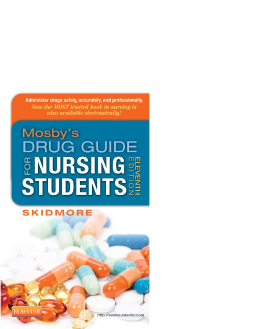
Additional Information
Book Details
Abstract
This portable, student-friendly reference provides information on 50 drug classifications and more than 4,000 individual generic and trade name drugs — including 20 new FDA-approved drugs. Drug monographs are organized alphabetically for quick reference, and important data on interactions and therapeutic outcomes is also included to help prevent errors. In all, this full-color reference equips you with all the information you could possibly need to master safe drug administration in a wide variety of scenarios.
- Monographs organized alphabetically by name allow fast retrieval of important information.
- Comprehensive drug monographs throughout the text contain:
- Generic names
- Rx or OTC designations
- Pronunciations
- U.S. and Canadian trade names
- Functional and chemical classifications
- Pregnancy category
- Controlled-substance schedule
- Do-not-confuse drugs
- Actions
- Therapeutic outcomes
- Uses
- Unlabeled uses
- Dosages and routes
- Available forms
- Adverse effects
- Contraindications
- Precautions
- Pharmacokinetics and pharmacodynamics
- Drug/herb, drug/food, and lab test interactions
- Nursing considerations
- Treatment of overdose
- Concise, practice-oriented nursing considerations include assessment, implementation, patient/family education, and evaluation.
- IV drug information is highlighted in one easy-to-find place, under the Implementation heading, and includes special considerations, Y-site, syringe, and additive compatibilities.
- High alerts drugs are identified by those that pose the greatest risk for patient harm if administered incorrectly.
- Canadian brand names are designated by a maple leaf icon.
- Nursing alert icons identify considerations that require special attention.
- Common and life-threatening side effects are highlighted for easy identification.
- Do Not Confuse headings help you avoid administering the wrong drugs.
- Tall Man lettering is applied to easily confused drug names, as recommended by the FDA.
- Therapeutic Outcome headings in monographs encourage critical thinking and provide a focus for the plan of care.
- Extensive interactions information including lab test interferences is included.
- Flexible, water-resistant cover provides durability in the clinical setting.
- Safe Medication Administration Guide in the back of the book includes a nomogram for calculation of body surface area.
- Drug Categories section features nursing diagnoses, generic drugs, and highlighted key drugs in each category.
- 13 illustrations and an atlas of medication administration show mechanisms or sites of action for select drug classes.
- Pharmacokinetics and pharmacodynamics in chart form offer easy access to information.
